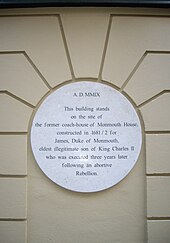Monmouth House

Monmouth House was a 17th-century mansion in Soho Square (then called King’s Square) built for the Duke of Monmouth, the oldest illegitimate son of King Charles II. After the Duke's execution for attempting to lead a rebellion against the unpopular Catholic successor to Charles, James II, the house was owned by the Bateman family and loaned to various important people including the French ambassador before being demolished in 1773.
History
[edit]In 1681, the Duke of Monmouth leased a large site on the South side of the square from Richard Frith and his partner Cadogan Thomas of Lambeth (a timber merchant), in association with Benjamin Hinton (citizen and goldsmith), and William Nutt of London (a merchant).[1]
Monmouth House occupied the south side of what was then called King’s Square. It was designed by Sir Christopher Wren and built in 1677 by a Mr Ford.[2] Today, there is an alley running through the site connecting Soho Square to Bateman Street, called Bateman's Buildings after Viscount Bateman, who owned Monmouth House in the mid-18th Century before it was demolished.[3] The house was redesigned by architect Thomas Archer for Lord Bateman's father, Sir James Bateman, Lord Mayor of London.[4] Archer also used the architectural design of a broken pediment on the façade in Chettle House, Dorset, whose roof was demolished in 1773, and in Roehampton House, where the damaged pediment was removed after 1780.[5]

It is not entirely clear why the Bateman family decided to demolish the house, but at the end of the 18th century the area seems to have fallen out of fashion: "as the stream of fashion was setting westwards, they [the Bateman family] travelled along with it, and, pulling down the mansion, let out the site on building leases."[6] The house was pulled down in 1773,[7] which freed up space for more houses in Frith Street, which runs south out of Soho Square. See also Numbering changes in Frith Street.
References
[edit]- ^ Sheppard, F.W. (1966). "Survey of London: Volumes 33 and 34, St Anne Soho". British History Online. London. Retrieved 17 May 2016.
- ^ "Monmouth House, King's Square (later Soho Square), Soho". Look and Learn. Retrieved 18 May 2016.
- ^ "Bateman's Buildings". Hidden London.
- ^ Summerson, John (1993). Architecture in Britain, 1530 to 1830, Volume 3. ISBN 0300058861. Retrieved 18 May 2016.
- ^ Baty, Patrick (21 September 2012). "Roehampton House". Patrick Baty. Retrieved 18 November 2016.
- ^ Thornbury, Walter (1878). "Soho Square and its neighbourhood', in Old and New London: Volume 3". British History Online. Retrieved 18 May 2016.
- ^ Hibbert, Christopher; Weinreb, Ben; Keay, John; Keay, Julia (2010). The London Encyclopaedia (reprint, 3rd ed.). Pan Macmillan. p. 557. ISBN 9781405049252.